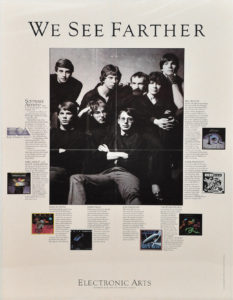Archive for the 'Floppy Emu' Category
Redesigning an Acrylic Case
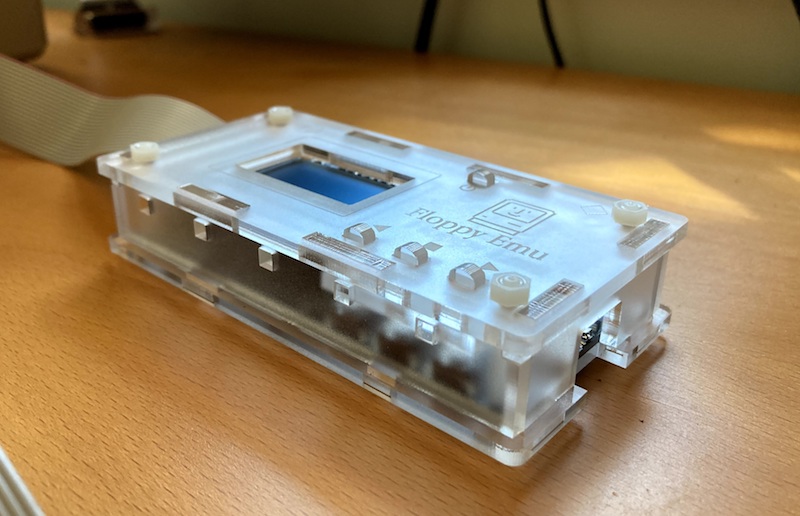
The acrylic case for BMOW’s Floppy Emu disk emulator is back in stock, along with the deluxe bundle of Floppy Emu with the case and SD card. Get them now at the BMOW store. This is a new version of the laser-cut acrylic case that I’m excited to introduce today.
Eagle-eyed readers may notice that this case looks subtly different from the previous version. I call it a “sandwich style” design because the top and bottom panels overhang the sides, holding the side pieces between them like cheese held between slices of bread. This differs from the previous case, whose six panels with interlocking notches were joined at flush edges with no overhang. The sandwich style ensures that all the side pieces are locked securely in place, and can’t wiggle loose after assembly.
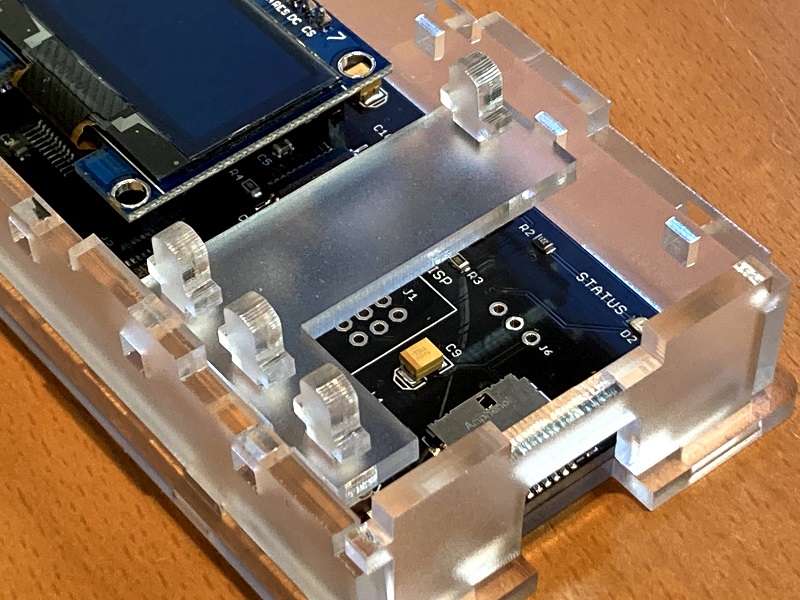
The changes continue inside the case, with the addition of a button guide for the button plungers. The button guide serves several important purposes. During assembly, it makes it possible to stand up the button plungers on the Floppy Emu’s buttons without the plungers falling over, so the top panel can be lowered down over them to finish the case assembly. This is much easier than the old method of suspending the plungers from the top panel with tape. After assembly, the button guide provides a second point of support for each plunger, ensuring that it moves straight up and down without unwanted angles or slippage. This also means the plungers’ functioning is independent of the case screw tightness, without any need to fine-tune the screws.
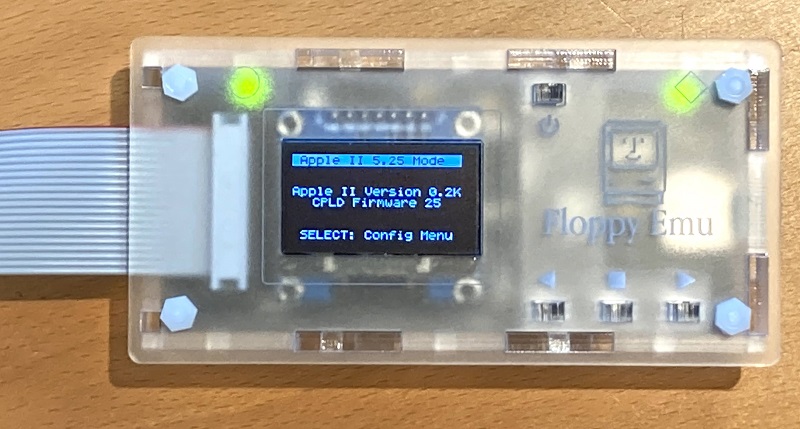
The last big change for the case is the introduction of top-panel engraved symbols for the power and status LEDs, instead of light pipes. The light pipes were fun, but they made case assembly substantially more difficult, and they’re not necessary when the top panel already functions nicely as an LED diffuser. The engraved symbols with diffuse LEDs give the new case a more minimalist look.
You may be surprised to learn this is something like the 15th version of the Floppy Emu case since I started making them! Most of those earlier revisions were small adjustments to fit or style, so this sandwich style redesign is the first really significant change. I’ve seeded some experienced Floppy Emu beta testers with the new case, and they report it takes about half the time for assembly and is better all-around. I hope you enjoy it!
Read 4 comments and join the conversationRetro Puzzle Contest: Solution

On Monday I posted a retro puzzle contest for vintage computing fans. Starting with only a confusing image of jumbled 8-bit characters, I promised that players would proceed through a tricky series of nested challenges, ultimately leading to the name of a person. If you’ve read the book (or seen the movie) Ready Player One, then you’ve seen this type of puzzle chain. I predicted that knowledge of vintage computers, software engineering, and 1980s cultural references would be helpful. And I offered a $100 gift certificate to whoever solved the puzzle and identified the mystery person first.
SPOILER ALERT! The puzzle was solved by the pseudonymous “frogor”, 28 hours after it was first posted. Congratulations! I’m going to describe the solution here, and the several different layers of the puzzle’s challenges. If you’d like to attempt solving the puzzle yourself first, read no further! It’s not an easy puzzle, and you won’t solve it in 5 minutes, maybe not in 5 hours, but you’ll find a retro-techno-challenge that’s worthy of the time you invest in it. See the original puzzle announcement here.
Level 1
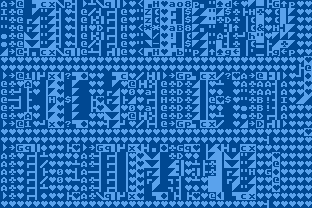
The puzzle begins with a 39 x 26 grid of random-looking letters, numbers, and symbols. OK, now what? Several people suggested that it was some type of ASCII autostereogram image. Others thought that if they squinted, they could sort of imagine three rows of large letter-type structures, separated by hearts. Interesting theories, but if you could simply stare at the first clue and see the answer, that would hardly be a “series of challenges”. No, that wouldn’t be a puzzle worthy of this audience.
But there are a lot of hearts in the image – what might their significance be? Also diamonds, clubs, and spades. And all the glyphs look conspicuously bitmap-y, like the glory days of 8-bit computers. And then there’s the odd choice of blue-on-blue color scheme. Hmm.
Identifying the font used in the image seems like a good idea. So how can you do that? If you’re lucky, you’ll recognize it immediately, because you were immersed in it for hours every day during your formative years. Otherwise, you will probably have to brainstorm the names of various vintage computers, look for examples of their character set fonts, and see if they look like a match. Some people pointed to code page 437, and others to PETSCII, which both look close but aren’t quite right. Some of their glyphs have slightly different shapes than the clue’s image, and a few glyphs from the clue’s image aren’t present in code page 437 or PETSCII fonts.
The font used here is actually ATASCII, from the Atari 8-bit series of home computers sold between 1979-1991. The blue-on-blue color scheme is a clue. Those are the default text colors used by the Atari 8-bit computers. And all those hearts? The heart is the first entry in the ATASCII character set.
Level 2
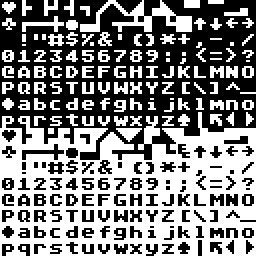
Atari font, check. Now what? Maybe it’s a clue? “Atari” plus random gibberish symbols equals the name of the mystery person? Maybe not.
A font map is a mapping between numbers and glyphs. In the case of ATASCII, there are 256 different glyphs corresponding to the numbers 0 through 255 – one byte. For example, the heart is ATASCII value 0, and the capital A is ATASCII value 65 (hex 0x41). Converting all the glyphs to the equivalent byte value seems like it could be useful, but how?
If you’re a masochist, you could open two side-by-side windows with the image from the clue and the ATASCII font map, and do the conversion by hand. There are about 1000 glyphs in the image from the level 1 clue, so this would take a long time, and you’d probably make some mistakes.
A better solution might be to write a small program to automate the process. Inspection of the clue’s image shows that each glyph is 8 x 8 pixels. So write a program to compare each 8 x 8 block from the clue’s image with 8 x 8 blocks from the ATASCII map, until it finds a match, and then record which ATASCII entry it was.
Even better, use some existing software to do the conversion for you. Frogor writes “I used ImageMagick with some character tables to break apart the grid into individual characters and automate mapping them to their character set byte values.”
When the conversion is done, you’ll have an array of 1014 bytes.
Level 3
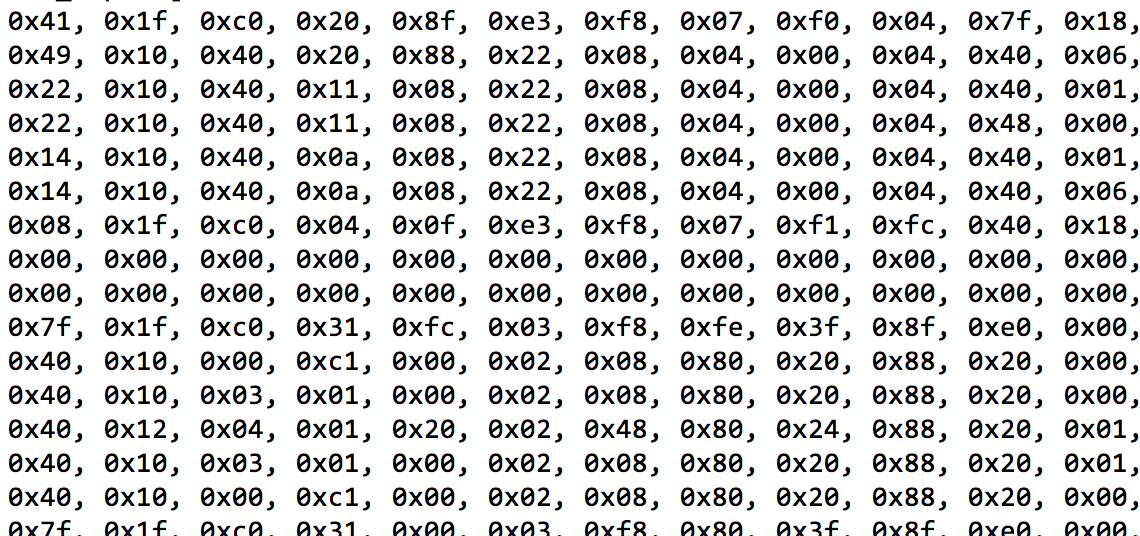
Now what can you do with this array of bytes? What is it? It seems to have some kind of structure: there are a large number of 0 bytes, and other values like 17 (hex 0x11) appear very frequently. It’s definitely not random data.
Making sense of the data is tricky. Maybe you can try to guess what sort of data I would put here, knowing the parameters and theme of the puzzle contest. Or maybe you have lots of hacking experience, and can recognize the raw forms of common file types and data structures just by staring at the bytes.
The people from level 1 who thought they could see three rows of large letter-type structures actually had a good idea. Frogor writes “I tried to figure out what my output -was- and could very definitely see some data structure by shifting the rows of hex bytes one character at a time. Since ‘file’ didn’t recognize it, I guessed it might be an image encoding of some sort – GraphicConverter RAW Import has an -amazing- visualizer which lets you play with the various settings until I tried as a last ditch effort a color encoding I probably should have started with.”
Yes, the bytes are a simple two-color bitmap, in raw form without any headers or other metadata. It’s just a grid of pixels. If you write each byte in binary, with a black pixel for a 1 bit and a white pixel for a 0 bit, then the 39 x 26 grid of glyphs from the first clue is converted into a 312 x 26 two-color bitmap image. Each one-byte glyph has eight bits which encode eight pixels horizontally, so the converted bitmap is eight times wider than the original grid of glyphs. And oh, what a bitmap it is.
Level 4

The upper-right of the bitmap says “BMOW RETRO PUZZLE AUG 2020”. Good, that tells you you’re in the right place. Then there’s some kind of weird code, and a couple of clock / arrow things pointing in different directions. Right.
It doesn’t take a rocket surgeon to recognize that this is some type of substitution cypher. Those boxy and wedgy shapes with dots inside them are clustered into groups that look like words, and the clusters
![]() and
and ![]()
appear twice, on both the second line and the third. Maybe you immediately recognize this as the Pigpen Cypher, a classic cypher that’s often used in games and puzzles. Or maybe you search Google for “cypher with lines with dots inside them”, and are rewarded with Pigpen Cypher as the top result.
It seems Frogor was initially stumped, but was saved by outside help. “The next stage of decoding gave a tantalizing clue in the first row – but figuring out the second and third rows I credit to a suggestion of a friend.”
Performing a Pigpen substitution for the second and third rows of the bitmap reveals some new text. But two of the dots don’t seem to be part of the Pigpen cypher.
Level 5

Here’s where knowledge of 1980s cultural references comes into play. “We see farther.” If you were alive in the 80s and were involved in the home computer scene, you recognize this as the slogan of game developer Electronic Arts. And if you don’t recognize it, Electronic Arts is the top search result for this phrase.
The other lines are just lists of numbers. There’s also a mystery dot on each line, and those clock / arrow things at the end of each line. What’s this all about? What if you replace the numbers with the corresponding letters of the alphabet? It sounds worth a try. That gives you DI·FCDG and H·CEFG. Ugh.
Maybe the numbers are referencing one of the people on this iconic Electronic Arts “We See Farther” poster?
Maybe those clock / arrow things are pointing to someone on the poster? Or maybe they aren’t actually clocks or arrows, but compasses pointing north and east? That looks interesting! In that case, the mystery dots could be decimal points for a latitude and longitude in decimal degrees format. Frogor says “in hindsight the helpers on the right side were nice confirmation of being on the right path”.
What is at:
49.6347 degrees north
8.3567 degrees east
Google Maps provides a quick and ready answer for the latitude / longitude lookup.
Level 6
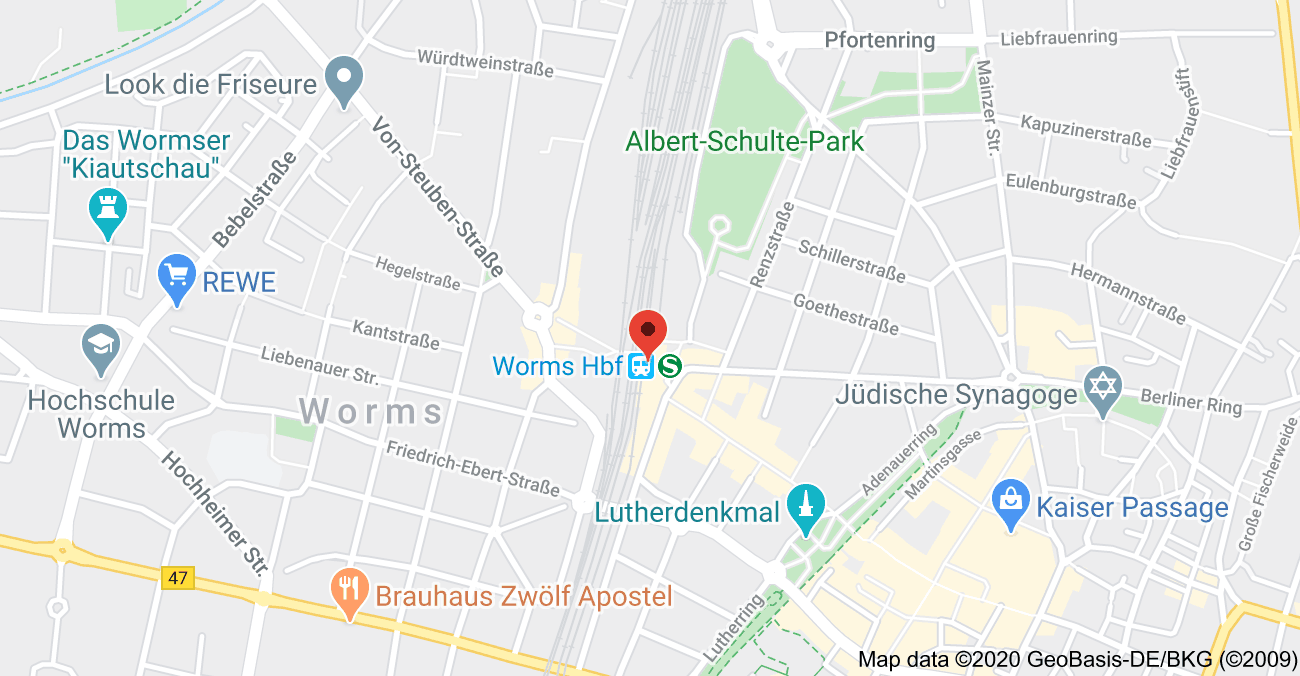
The location is somewhere in Germany, at something called “Worms Hbf”. Your German-speaking friend or a dictionary will tell you that Hbf is an abbreviation for Hauptbahnhof, the main train station in a city. Investigating the map further confirms that 49.6347 N, 8.3567 E is the location of the central train station in the city of Worms, Germany.
Level 7
WE SEE FARTHER
ELECTRONIC ARTS
WORMS, GERMANY
We see farther. Electronic Arts. Worms. All the pieces are here, but what do they mean? Is there some other clue in these words? If there’s some connection here, it’s not obvious.
If you go back to that Electronic Arts poster again, and take a closer look:
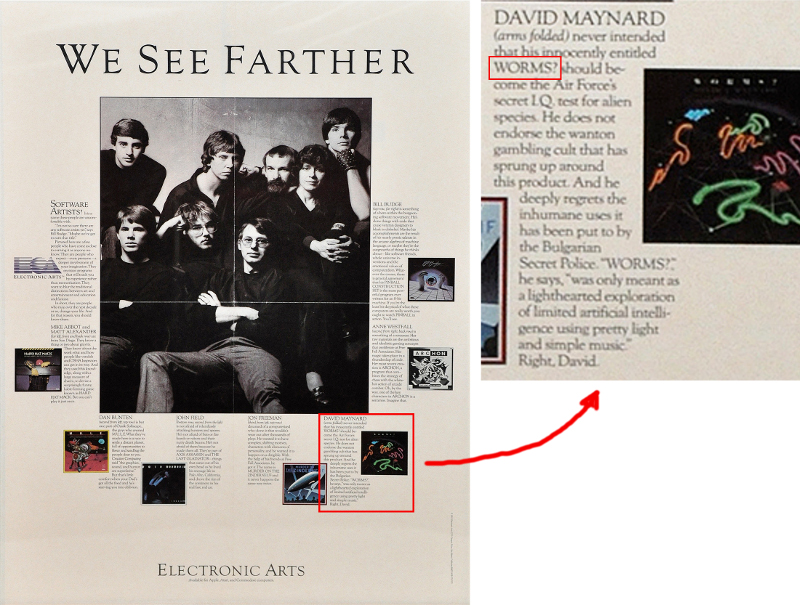
DAVID MAYNARD (arms folded) never intended that his innocently entitled WORMS? should become the Air Force’s secret I.Q. test for alien species. He does not endorse the wanton gambling cult that has sprung up around this product. And he deeply regrets the inhumane uses it has been put to by the Bulgarian Secret Police. “WORMS?”, he says, “was only meant as a lighthearted exploration of limited artificial intelligence using pretty light and simple music.” Right, David.
Seven levels deep into the puzzle, the mystery person is finally revealed! Phew! Success at last.
Creating the Puzzle
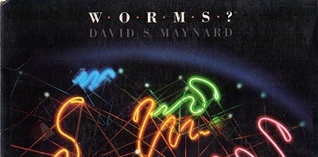
My original inspiration for this puzzle was simply “encode some stuff in ATASCII”. My first computer was an Atari 800, and I spent many hours staring at its strange square letters and symbols. They’re etched in my brain.
The idea to use an obscured latitude and longitude came from Brainchase. If you have kids that enjoy puzzles, they’ll love Brainchase. Or forget your kids and sign up for yourself. The first levels of their puzzles are simple enough for even young kids, but to finish them all requires hardcore problem-solving skills. And they have super cool prizes like buried treasure.
Eventually I arrived at the central idea: a latitude/longitude that points to a city whose name is also an English word, that when combined with another phrase, will uniquely identify somebody. “We see farther” jumped into my head immediately as a recognizable 1980s phrase that fit the puzzle’s retro-computer theme. I played loads of EA games as a kid, and also worked at Electronic Arts for many years as an adult.
To make the puzzle fit together, I needed to find an EA game whose name was also the name of a city. And it couldn’t be just any EA game, it needed to be an early game from the era when “We see farther” was still in use. There are no cities named “Archon” or “Pinball Construction Set”, but Worms fit the bill perfectly. So you see, I didn’t actually choose the mystery person. I chose the puzzle format, and the identity of the mystery person was determined for me.
Finding a latitude/longitude for Worms was harder than I expected. A city is a large place; it doesn’t have a precise latitude/longitude. No matter what coordinates I entered into Google Maps, the default behavior was to show a very zoomed-in view of streets and individual buildings, rather than a regional or national map of Germany. I worried this might give people the wrong idea. Would they understand that the clue meant the whole city of Worms, and not some random shopping mall or Burger King in the city? What building should I point to? I eventually settled on the train station as a stand-in for the city itself.
For the Pigpen cipher, I created a custom Pigpen font using Bitfontmaker2. This probably wasn’t necessary, but it was fun to type my secret messages in plaintext and have them automatically rendered in Pigpen. The other elements of the bitmap were drawn in by hand, to create the finished bitmap shown in level 4.
I used LVGL’s Online Image Converter to turn the bitmap into an array of hexadecimal bytes. Then I wrote a short Python program to turn the hex bytes into decimal bytes spread across DATA statements for use with BASIC. As a final step, I wrote an ATARI BASIC program and ran it in the Atari800MacX emulator.
10 FOR R=1 TO 26 20 FOR X=1 TO 39 30 READ NUM 40 PRINT CHR$(27);CHR$(NUM); 50 NEXT X 60 PRINT 70 NEXT R 1000 DATA 65, 31, 192, 32, 143, ...
CHR$(27) is the escape sequence. It ensures that control characters like tabs, newlines, and the bell are rendered as ATASCII glyphs instead of performing their control functions. Running this BASIC program created the finished image used for the first clue at level 1. Because the image came from a real (emulated) Atari rather than some paint program, I could be confident the glyphs, colors, and spacing were 100% accurate. This ensured that people could correctly identify the font, and do a pixel-by-pixel comparison against the ATASCII font map if necessary.
A Sequel?
I really enjoyed developing this puzzle, even though it took a long time to create. I also enjoyed watching other people’s thought processes as they tried to solve it. A friend of mine “live-texted” me his progress, which was lots of fun, even though he never finished.
I was a little bit disappointed that more people didn’t attempt the puzzle. Maybe lots of people took a brief look at it, weren’t sure where to begin, and immediately gave up. Or maybe people didn’t really understand what kind of puzzle it was, or why it might be interesting and worthwhile for them to invest time in solving it.
That leads to thoughts of a sequel. Now that puzzle #1 is done, and more people understand what this puzzle format it all about, I’m hoping there might be greater interest in a new one. I would enjoy the challenge. Would you?
Read 3 comments and join the conversationFloppy Emu Restock and Retro Puzzle Contest

The BMOW Floppy Emu disk emulator is back in stock and shipping now. Get yours and other BMOW hardware goodies at the store. But before you place your order, you might wish to try your hand at a special challenge.
Are you ready to test your nerd skills and win some prizes? It was quieter than usual around BMOW labs during the out-of-stock period, so I used the opportunity to design a devious retro-computing puzzle. What’s this crazy mess of blue and white symbols? Beginning with only this clue, skilled retro-nerds will work through a series of challenges that will eventually lead to the name of a person. Knowledge of vintage computers, software design, and 1980s cultural references will be helpful. Whoever is first to post the mystery person’s name in the comments section here wins a $100 BMOW gift certificate and one million internet fame points! You may use Google or any other tools you think might help. This is not an easy puzzle, but BMOW readers are a crafty and clever bunch. Ready… go!
Read 11 comments and join the conversationAcrylic Cases Back in Stock
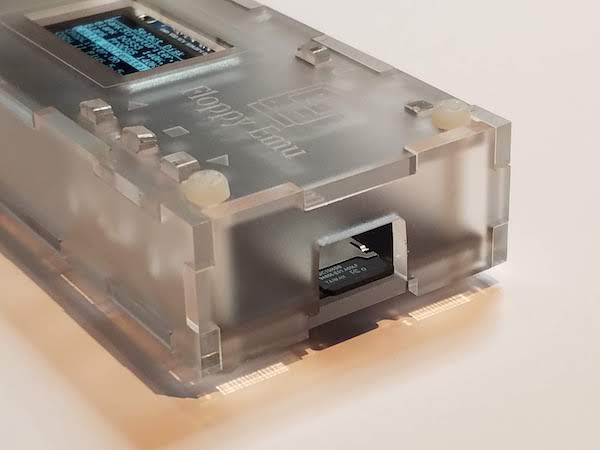
Acrylic cases for the BMOW Floppy Emu and ADB-USB Wombat are back in stock. If you’ve been waiting for one of these, your wait is over. The Floppy Emu cases were held up longer than expected due to international shipping delays, which continue to be a major challenge. The Wombat cases are made locally, but the manufacturer has mostly transitioned to making emergency medical protective equipment and is processing other work slowly. To compound the problem, the first delivery of Wombat cases were somehow mis-cut at 15/16ths the correct size. The whole batch had to be thrown in the trash, and new cases re-cut. Sometimes even the simple things are hard!
Read 3 comments and join the conversationFloppy Emu Update: Favorites, Lisa Fixes, and More
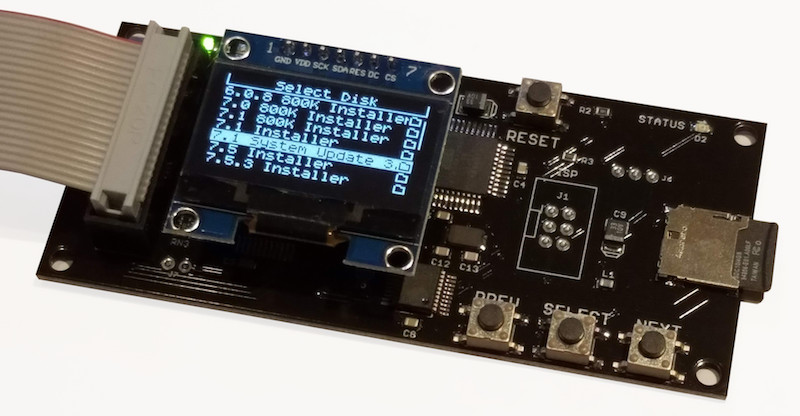
New features have arrived for the BMOW Floppy Emu disk emulator! This update has something for everyone.
Favorites Menu
If your SD card contains hundreds of disk images or many deeply-nested subdirectories, navigating through the contents of the card can become tedious and slow. For convenience, an optional Favorites menu can now be configured. At startup the Favorites menu will be shown instead of the standard File Explorer menu. If needed, you can exit the Favorites menu at any time in order to choose non-favorite disk images.
The Favorites menu is configured using a plain text file named favdisks.txt. This file should be placed in the top-level root directory of your SD card. In this file, list the path to each favorite floppy disk image, one per line. An example file is included with the Floppy Emu’s firmware update package, which can be downloaded from the BMOW web site.
Auto-mounting
The Macintosh and Lisa will wait patiently for you to insert a boot disk, but most Apple II computers will give up if a boot disk isn’t found within a few seconds after power-on. To make life easier, past versions of the Apple II compatible firmware included a simple auto-remount behavior. At power-on, the most recently used disk was automatically re-mounted, if the disk was inserted when the power was turned off last time.
This new firmware enables further control over the Apple II automount behavior, using an optional automount directive on the first line of the favdisks.txt file. This is just the word “automount” followed by a space and a single digit:
- 0 – Never automount. The Floppy Emu will always power up to display your Favorites menu.
- 1 – Always automount the first disk image listed in favdisks.txt
- 2 – Automount the most recently used disk, if there was a disk inserted when the power was turned off last time.
Automounting is only supported for the Apple II floppy disk emulation modes. The automount directive has no effect in other emulation modes, or for Macintosh / Lisa disk emulation.
Lisa 2/5 Fixes
Unlike the Lisa 2/10, the Lisa 2/5 doesn’t have an IWM chip for processing floppy disk signals. It uses a collection of discrete logic chips to accomplish the same result. For several years I’ve struggled to understand why the Floppy Emu firmware works poorly with the Lisa 2/5, and now I finally have the answer.
To detect a “1” bit from the floppy drive, the computer looks for a high-to-low transition occurring somewhere in the 2 microsecond bit window. It repeatedly samples the signal during that 2 microsecond window, looking for a transition. It turns out that the IWM samples the signal at a higher rate than the Lisa 2/5 discrete logic. The high periods of Floppy Emu’s “1” bits were too short to be reliably detected by the Lisa 2/5 level-sensitive hardware. This firmware update doubles the width of the high period, and my Lisa 2/5 testers report that it’s now working smoothly.
Floppy Emu for Visually Impaired Users
Several small tweaks have been made to improve the experience for visually impaired users. A new appendix has also been added to the instruction manual, with a detailed description of the behaviors necessary to use the Floppy Emu without seeing the display. The favorites menu was initially developed as a tool for blind users, before being extended into a general-use feature. With the Favorites menu, any desired disk image can be chosen reliably by counting how many times you’ve pressed NEXT before pressing SELECT to insert the disk.
Today’s firmware update also introduces an optional emumode.txt config file, which simplifies the process of changing the emulation mode by reducing the number of button presses needed. If this file is present, then as soon as the emulation mode menu is opened, the Floppy Emu will automatically change the emulation mode according to the ID specified in the file. An example file is included with the Floppy Emu’s firmware update package.
Download the New Firmware
Mac/Lisa firmware: mac-lisa-0.8G-F15
Apple II firmware for Floppy Emu Model B and C: apple-II-0.2L-F25
Floppy Emu SoftSP Warning
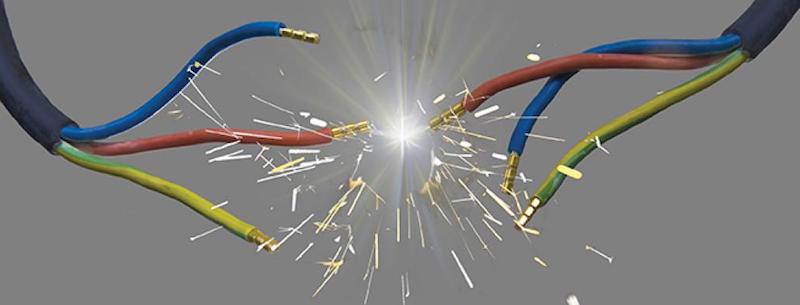
I’m calling attention to a hardware issue with the third-party “softSP” card that can damage your Floppy Emu when the two are used with a Disk II controller card in an Apple II+ or Apple IIe. This issue creates a power-to-ground short circuit that will cause accumulating damage to the transistor structures on Floppy Emu’s interface chip. The symptoms don’t appear immediately, and it may seem that everything’s OK for days or weeks, until the Floppy Emu begins to fail irreversibly. The good news is that a simple cable modification is all that’s needed to use softSP and Floppy Emu together safely.
softSP Pseudo-Smartport
BMOW isn’t affiliated with the softSP card – it’s sold by a third party and is designed for use with another type of disk emulation product. It does appear to work with the Floppy Emu initially, and in recent months the Total Replay game collection has inspired a few people into using softSP with the Floppy Emu. Some popular YouTube videos even specifically recommend this combination, even though softSP isn’t designed for use with the Floppy Emu.
The problem is that softSP provides a software patch for Apple II disk controller functions, but does nothing to address the resulting low-level electrical problems on the disk interface. The softSP card contains a small ROM that overrides the built-in ROM on a standard Disk II controller card. It essentially reprograms the Disk II card, so instead of functioning as a 5.25 inch floppy disk controller, it now functions like a Smartport disk controller, which supports block-based disk I/O for disk sizes up to 32 MB. Neat! But there’s a catch.
You can’t safely connect a Smartport device to a Disk II controller card, no matter how the card’s internal logic might be modified. That includes Floppy Emu when it’s configured in Smartport emulation mode. The reason is that Smartport devices connect pin 12 internally to ground. This is how other connected equipment and daisy-chained drives know that they’re Smartport drives, and it’s essential for correct daisy-chain operation of Smartport drives with the BMOW Daisy Chainer or the Apple Unidisk 3.5 drive. For other types of Apple II disks as well as the Macintosh and Lisa, pin 12 is used for the SELECT signal. But on the Disk II controller card, pin 12 is connected to the +5 volt power supply. So when you connect a Smartport device to a Disk II controller, you create a direct power-to-ground short circuit. Ouch!
To be clear, there’s no specific hardware problem with the softSP card itself – it’s just a ROM. The problem arises when using the softSP card to reprogram a Disk II controller card, which is then connected to a Floppy Emu that’s configured in Smartport emulation mode.
Accumulating Chip Damage
The Floppy Emu board has a small inline protection resistor that will prevent immediate damage and failure due to this short circuit, but it’s only meant to protect against brief transients during power-up and power-down, or brief accidental mis-configuration. The Floppy Emu’s CPLD interface chip will likely not survive sustained operation in this mode, because it will cause a continuous current on pin 12 due to the short circuit, with a current level that’s more than twice the absolute maximum rating of the chip. This can eventually cause damage to the chip that will appear as intermittent disk errors or total failure of the device. Unfortunately this type of damage is cumulative, so even if you stop using Smartport mode with softSP and a Disk II card, the damage is already done.
With the continuous over-current, the insulating silicon layers between parts of a transistor can wear away, or develop small holes. At first the effect is minor – maybe the leakage current is more than it should be, or the noise margins are reduced below the spec. The chip may still work OK under normal conditions, but problems may appear under extraordinary conditions at high/low temperatures, or when the supply or signal voltages are close to the rated margins, or when substantial EM noise or voltage transients are present. A problem might cause a 0 to become a 1 somewhere, resulting in a visible I/O error, or it might cause the whole chip to stop functioning until power is turned off. As chip wear grows worse, you may start to see these kinds of problems during ordinary usage. Eventually the problems will grow so frequent that the chip is no longer really usable, or the wear will progress all the way to an internal short-circuit or open circuit within the chip itself, effectively destroying it.
This kind of chip damage can be viewed as a type of gradual wear, like wearing down the engine in your car, rather than a simple yes/no question of is it damaged or not-damaged. Even normal use causes chip wear, and chips do have finite lifetimes, but normally the lifetime is measured in decades or longer. In this case the power-to-ground short circuit is like driving your car without enough oil in the engine. It’ll work for a while, but you’ll start to notice it’s running increasingly rough, and maybe it’ll develop occasional trouble with stalls or failure to start. Then one day the engine will completely seize up and the car will no longer run at all.
Cable Modification Fix
A simple work-around is to sever the 12th wire of the 20-conductor ribbon cable. The red wire is number 1, so simply count wires from there and cut number 12 using a small nail or a razor blade. The resulting cable will work for softSP Smartport emulation with a Disk II controller card, without creating a power-to-ground short circuit. It will also work for standard Apple II 5.25 inch floppy disk emulation. But the modified cable won’t work for true Smartport emulation with other Smartport hardware, nor for 3.5 inch floppy disk emulation, nor for Macintosh or Lisa disk emulation. If you don’t want to modify your original ribbon cable, you can get a spare cable from DigiKey for a few dollars.
Unfortunately modifying the cable won’t undo any damage that’s already been done, so if you plan to use softSP with your Floppy Emu, you’ll need to make this cable modification right from the start. Be safe!
Read 13 comments and join the conversation

